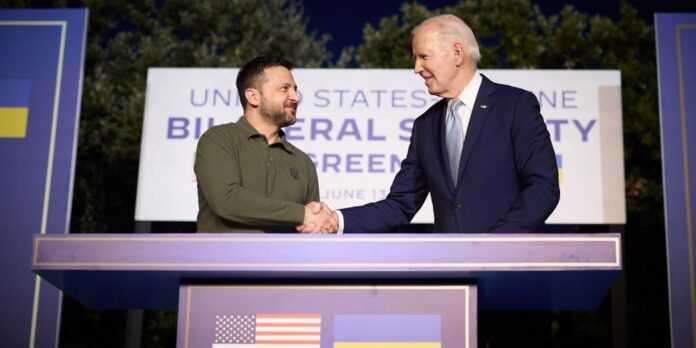- The Group of Seven has agreed in principal to provide Ukraine with a $50 billion loan.
- Profits from Russian frozen funds are to be used as collateral to back the loan.
- But some analysts don’t see the move as doing enough, calling for total confiscation of Russia’s assets.
The Group of Seven has finally moved the dial on a contentious idea to provide funding to Ukraine by using Russian funds.
After months of headbutting, leaders have reached a compromise that offers Kyiv a major financial lifeline. As collateral, the G7 will tap profits generated by Russian reserves that were first frozen in 2022.
“This week, the G7 signed a plan to finalize and unlock $50 billion from the proceeds of those frozen assets — to put that money to work for Ukraine, another reminder to Putin that we’re not backing down,” President Joe Biden said in a speech during the G7’s June meeting.
What is the deal about?
Roughly $322 billion in funds were frozen after Moscow invaded Ukraine and have sat untouched for over two years. During that time, the assets have continued to accumulate interest and profits.
With Ukraine’s situation growing dimmer, the US has pushed to completely confiscate the assets, and has even given Biden the ability to take control of Russian funds held by the US.
Yet some $280 billion is actually frozen in Europe, which has been less keen to seize the funds. At most, the European Commission has agreed to transfer around $3 billion of the generated profits to Kyiv annually.
The G7’s agreement is a meeting in the middle, and uses about 20 years’ worth of the interest to back the $50 billion figure.
“This is a pretty meaningful step in terms of bridging the gap that exists between the US and Europe,” Council of Foreign Relations president Michael Froman told CNBC. “It sort of sends a signal that there will be funding available for reconstruction, we’re helping Ukraine build up its military industrial capability.”
What’s Russia’s response?
While it will take weeks to finalize details of the loan, concerns are already cropping up.
One question is how the loan will be repaid if, for instance, the funds become unfrozen, or interest accrued on the assets fluctuates.
Another issue concerns the plan’s survivability amid shifting G7 leadership.
While Biden is a staunch supporter, the loan will likely take until the end of the year to materialize. By then, the US election may put Republican candidate Donald Trump in charge, who has opposed aid to Ukraine.
But the biggest worry lies in how the Kremlin will react, given that Moscow warned against touching its assets. Already, President Vladimir Putin has called the G7’s plan “theft” and promised punishment.
That could mean Moscow taps Western funds in the country and punishes any Western companies that have remained in Russia. The Center for European Policy Analysis has warned that those firms could lose access to assets ranging from securities to real estate.
Is $50 billion enough?
“Fifty billion dollars is over half of Ukraine’s total expenditures in 2023—a game-changing amount,” the Atlantic Council’s Charles Lichfield wrote, adding: “We should appreciate how elegantly today’s compromise navigated the red lines of France, Germany, and other EU member states, while still providing a substantial amount.”
But others only consider it just a first step, as the pact is inadequate to address all of Ukraine’s needs.
According to Chatham House’s Timothy Ash, the package is enough to cover only six months of Ukraine’s funding needs and is just one-third of what Kyiv requires to jumpstart a military offensive.
Instead, seizing control of the reserves would be simpler. In his view, geopolitical and economic risks are overstated, and there is strong legal backing to do so, he wrote for CEPA.
Politicians are also coming on board.
On Tuesday, a group of Western legislators published a letter in the Financial Times that argued for a major policy step up, noting that Russia’s war has already done 500 billion euros worth of infrastructure damage.
“If we confiscate the entire €300bn in accordance with international law, we affirm the legal right to take countermeasures when a state like Russia grossly violates international law with its aggression,” they said.




